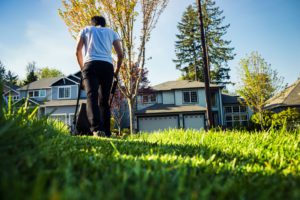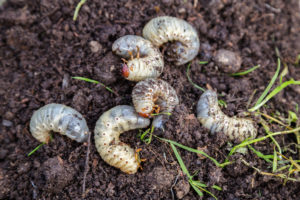Growing A Healthy Lawn in Ontario
It’s time for long summer days spent outdoors, and the lawn becomes central to fun family activities, backyard picnics, and lounging in the sun. Growing a healthy lawn doesn’t have to be complicated. How can we keep it green and thriving? Let’s have a look at the most frequently asked lawn care questions. 
When do I start mowing?
Once the grass begins actively growing and newly-seeded areas have been sprouted for about 10 days, you can begin to mow. It can be tempting to chop grass way down at first, but resist this urge. To keep the turf healthy, reduce drought stress, and lower the risk of pests and diseases, it’s recommended to mow at the highest or second-highest setting on the mower. This means allowing the turf to be maintained at a height of 2.5 – 3″. Keeping slightly longer grass allows for a deeper, stronger root system and a healthier lawn!
Are you bagging and discarding your grass clippings? Ditch the bag and allow your grass clippings to remain on the lawn. This process allows vital nutrients to be recycled back into the lawn, and the mulching effect acts to provide some shade to the roots in the hottest, driest periods.
How often should I fertilize?
Like all living plants, turf grasses need nutrition in order to grow and thrive. It’s best practice to feed every 6-8 weeks with a high-quality lawn food while the lawn is actively growing. Lawn food is available in different formulations that are suited to the season. Choosing a fertilizer that’s designed for spring, summer, or fall will help to support your lawn’s specific needs in each season.
In mid-summer in Ontario, it’s normal for lawns to go dormant and turn the colour of straw. This is a protective measure that allows the grass to stay alive when it’s simply too hot and dry to grow. Pause feeding in this period, and resume when the cooler temperatures and rainfall allow the lawn to begin growing again.
What about watering?

Your lawn needs about an inch of water each week, which is generally provided in spring. In dry spells, it’s best to water early in the morning, ideally before 10am. Giving the lawn a good soak in the early part of the day helps to ensure that the moisture is reaching deep into the soil, rather than being lost to wind and evaporation. In general, most sprinklers will provide sufficient water in 20-30 minutes. If possible, try to avoid watering in the evening. When grass sits wet in the dark, humid conditions of summer nights, it’s more likely to develop fungal diseases. Shop watering and irrigation supplies here.
How do I control weeds?
A healthy lawn doesn’t need to be completely devoid of weeds. However, to control common broadleaf weeds, use a weed control product like Weed B Gon on sunny days for best results. In spring, it’s often best to get ahead of weeds by manually removing stubborn weeds with weeding tools and filling bare patches with seed to repair. Overall, the best long-term defence against weeds is a thick, healthy lawn. Following good maintenance practices will help your lawn to grow rapidly and crowd out unwanted weeds.
HOW Can I treat for grubs?
 White grubs cause damage to the lawn in a few ways. These larvae of Japanese Beetles munch on the tender roots of turf, leaving large brown patches and weakening the lawn. In addition, they’re a favourite food of skunks and raccoons. The bigger problem with grubs is often the damage caused by these larger animals digging into the ground for snacks! If there is evidence of white grubs in the lawn, timing the treatment properly is important. From mid-April through to early June, white grubs are actively feeding close to the soil surface. This is the best time to target them with treatment, since making contact with the larvae is critical for it to be effective. Grub B Gon or beneficial nematodes are the best control products for white grubs in Ontario.
White grubs cause damage to the lawn in a few ways. These larvae of Japanese Beetles munch on the tender roots of turf, leaving large brown patches and weakening the lawn. In addition, they’re a favourite food of skunks and raccoons. The bigger problem with grubs is often the damage caused by these larger animals digging into the ground for snacks! If there is evidence of white grubs in the lawn, timing the treatment properly is important. From mid-April through to early June, white grubs are actively feeding close to the soil surface. This is the best time to target them with treatment, since making contact with the larvae is critical for it to be effective. Grub B Gon or beneficial nematodes are the best control products for white grubs in Ontario.
Should I apply grass seed?
Spring and early fall are the best times to seed your lawn. Applying a layer of seed to your established lawn to fill spaces and thicken the turf each season is called overseeding. This practice helps to keep weeds at bay, and to repair weakened or damaged areas. Turf grass seed blends are available in a range of mixes, with different types of grass that are adapted to the conditions of your lawn. Blends for shade, sun, low-maintenance, high-traffic, or the ultimate Kentucky bluegrass are all unique. No matter your chosen blend, use a spreader for even application. Keep new seed watered until it germinates, which usually takes 7-10 days.

